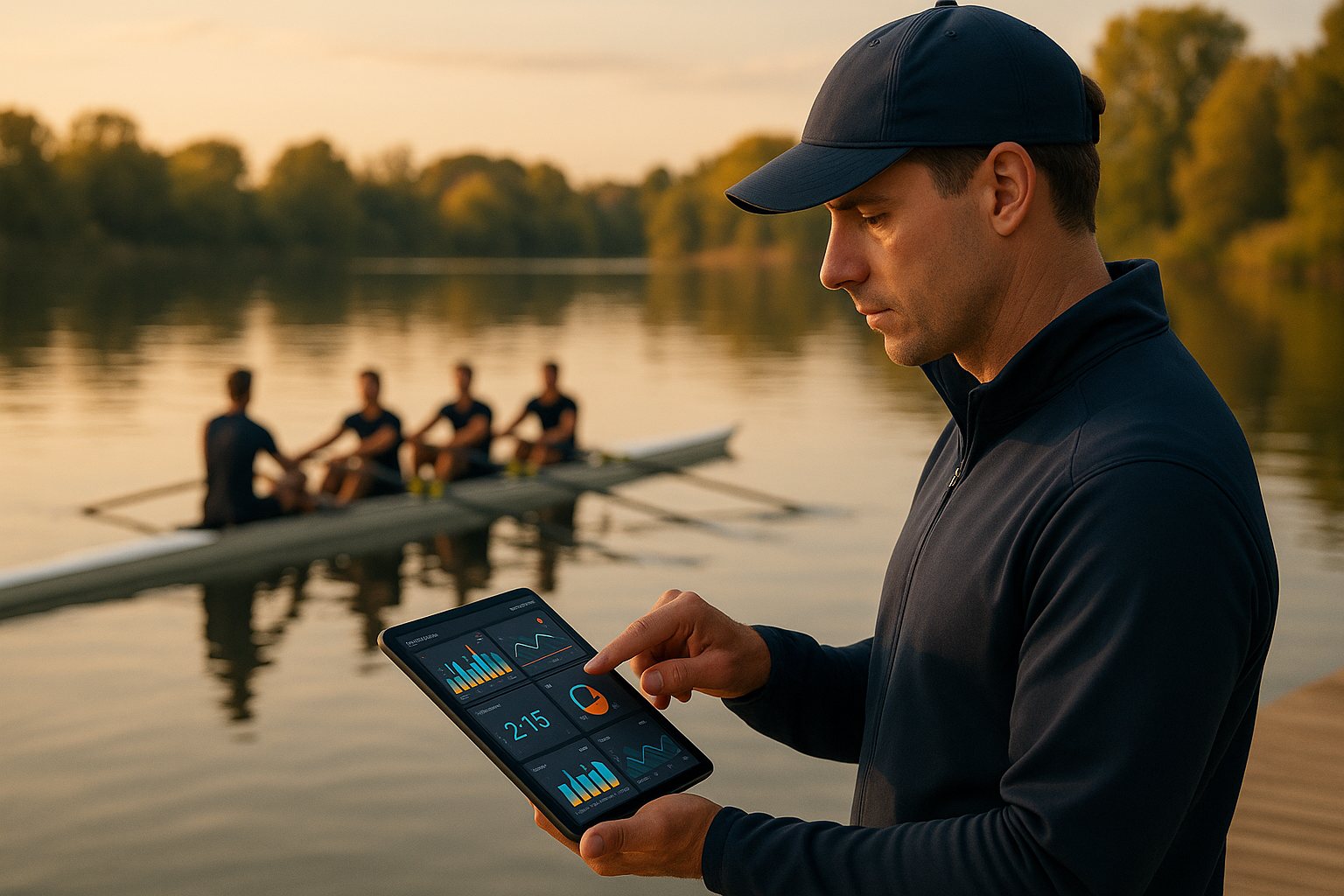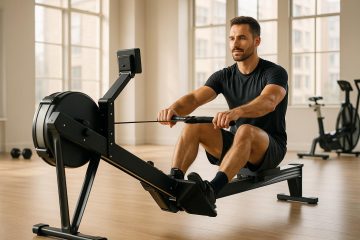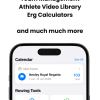
How Cloud Dashboards Improve Rowing Coaching
Cloud dashboards are transforming rowing coaching by centralizing data, enabling real-time performance monitoring, and improving team communication. They allow coaches to track metrics like stroke rate, heart rate, and GPS data in one place, making it easier to provide immediate feedback and create personalized training plans. These tools also simplify scheduling, attendance tracking, and lineup management, while fostering collaboration among coaching staff. Key benefits include:
- Real-time data access: Coaches can monitor live metrics during training sessions.
- Centralized information: All performance data, attendance, and athlete profiles in one platform.
- Improved communication: Built-in messaging keeps teams updated on schedules and feedback.
- Enhanced analysis: Tools to track trends and compare athlete progress over time.
While these systems streamline workflows, challenges like internet dependency, cost, and data security must be considered. Choosing the right dashboard involves assessing your team’s needs, budget, and technical skills to ensure effective integration.
Video 1c. The Coach Bergenroth Rowing App – Data Analysis and Force Curve Analysis Functionality.
Key Features of Cloud Dashboards for Rowing Coaches
Cloud dashboards are reshaping the way rowing coaches manage their teams by offering tools that streamline training, enhance communication, and improve performance tracking. These platforms bring together essential features that make coaching more efficient and effective.
Centralized Data Collection
One of the standout features of these dashboards is their ability to consolidate all training data into a single, unified interface. They gather information from various devices like heart rate monitors, GPS units, and stroke rate sensors. On top of that, coaches can manually log details such as technique observations, weather conditions, and athlete feedback – all within the same platform.
Attendance tracking becomes a breeze with integrated roster management. Coaches can easily mark attendance, note injuries or absences, and monitor participation trends. This historical data is invaluable for spotting patterns, planning lineups, and analyzing team performance over time.
Additionally, these systems store performance benchmarks and testing results, allowing coaches to compare current metrics with past data to track athlete progress and identify areas for improvement.
Real-Time Monitoring and Access
Real-time monitoring is a game-changer, especially for remote training sessions or managing multiple groups simultaneously. Coaches can view live data streams from athletes’ devices, enabling them to make immediate adjustments to workouts or offer feedback on technique.
The mobile accessibility of these dashboards ensures that coaches are never out of the loop. Whether they’re on the road or away from their desk, they can use their smartphones or tablets to check athlete progress, review training data, or communicate with the team.
Automatic data synchronization across devices eliminates the headache of outdated information. Updates made on one device, like a laptop, instantly appear on others, ensuring everyone has access to the latest data at all times.
Team and Session Management Tools
Cloud dashboards also excel in team and session management. Coaches can create detailed athlete profiles that include emergency contacts, medical information, skill assessments, and personal goals. These profiles update automatically as new data is added, keeping everything current.
Practice planning is simplified with session scheduling tools. Coaches can design workouts, assign training groups, and outline equipment needs. Athletes are notified automatically about schedule changes or weather-related updates, saving time and reducing confusion.
When it comes to racing season, lineup management becomes a powerful tool. Coaches can experiment with different boat combinations, track their performance during practice, and maintain records of successful lineups for future reference.
Built-in messaging features keep everyone connected. Coaches can send messages to specific groups, share workout results with individual athletes, or make announcements to the entire team. Many platforms also support file sharing, making it easy to distribute training plans, race schedules, or instructional videos.
Together, these features create a cohesive system that simplifies coaching workflows and helps teams perform at their best.
How Cloud Dashboards Improve Rowing Coaching Workflows
Cloud dashboards are transforming rowing coaching by bringing together centralized data, real-time monitoring, and streamlined workflows. These tools free up coaches to focus on what matters most – helping athletes reach their full potential.
Streamlined Practice Planning
With cloud dashboards, practice planning becomes more efficient. Coaches can quickly access up-to-date performance metrics, training loads, and athlete availability to create workouts tailored to each athlete’s current fitness and recovery needs. This data-driven approach ensures every session is purposeful and aligned with the team’s goals.
Dashboards also integrate local weather forecasts, helping coaches adapt training plans on the fly. For instance, if unexpected weather disrupts outdoor practice, coaches can instantly switch to an alternative training mode and notify the team through built-in messaging features. This seamless communication keeps everyone informed and minimizes downtime.
Performance Tracking and Feedback
Real-time performance tracking is a game-changer for rowing coaches. Dashboards allow them to monitor live metrics like stroke rate, power output, and heart rate zones during training. This visibility enables immediate adjustments and more effective on-the-spot coaching.
Performance reports generated by the dashboard highlight key metrics and trends, making it easier for coaches to assess progress. Personalized feedback becomes more impactful as coaches can send detailed summaries to athletes right after practice. These summaries often include charts, comparisons to goals, and specific recommendations, ensuring the feedback is actionable while the session is still fresh in the athlete’s mind.
The ability to visualize data also helps coaches communicate progress to athletes, parents, and team administrators. By spotting trends like performance plateaus or peak fitness periods, coaches can refine training phases to optimize results.
Better Communication and Collaboration
Strong communication is essential for team success, and cloud dashboards make it easier than ever. Coaches can use targeted messaging to address specific groups – like varsity, junior varsity, or novice rowers – while also sharing important updates with the entire team when needed. This ensures everyone stays on the same page.
Collaboration between coaching staff is also enhanced. Head coaches, assistant coaches, and strength trainers can all access the same athlete profiles, performance data, and training plans. This shared access ensures the entire coaching team is aligned and working toward the same objectives.
In emergencies, dashboards provide instant access to critical information like medical details and emergency contacts, saving valuable time when quick action is required. Some platforms even include video analysis tools, allowing coaches to upload and annotate technique videos. By combining visual feedback with performance data, coaches can offer athletes a more comprehensive understanding of their strengths and areas for improvement.
These tools not only streamline workflows but also empower coaches to elevate their team’s performance to new levels.
Pros and Cons of Cloud Dashboards
Cloud dashboards bring a mix of advantages and challenges to rowing coaching. While they can streamline practice planning and provide real-time feedback, they also come with hurdles that require careful consideration. Understanding both the upsides and downsides will help you decide if these tools align with your program’s needs.
Benefits vs. Challenges Comparison
Before committing to cloud dashboards, it’s important to weigh their key benefits against potential drawbacks:
| Benefits | Challenges |
|---|---|
| Real-time data access from anywhere with an internet connection | Internet dependency – no connection means no access to critical performance data during training |
| Centralized athlete information including performance metrics, health data, and training history | Data privacy risks – storing sensitive athlete information in the cloud increases exposure to breaches and cyber-attacks |
| Streamlined communication with targeted messaging for different team groups | Implementation costs – initial software investment, staff training, and ongoing maintenance can strain budgets |
| Enhanced collaboration between coaching staff through shared athlete profiles | Data quality concerns – inaccurate or incomplete input data can lead to misleading insights and poor decisions |
| Automated reporting that reduces time spent on administrative tasks | Technology over-reliance – risks losing traditional coaching instincts and personal athlete connections |
| Scalable solutions that adapt as your program grows | Complex integration with existing systems, which may require significant IT infrastructure updates |
While the benefits are appealing, several challenges stand out for their potential to disrupt coaching practices.
Internet connectivity is a major issue. Many rowing programs operate in outdoor environments where reliable internet access isn’t guaranteed. If your dashboard goes offline mid-session, you lose the ability to monitor and adjust performance in real time – undermining the very purpose of the tool.
Data security is another pressing concern. Sensitive athlete information stored in the cloud is vulnerable to breaches, which could lead to legal and financial consequences for your organization.
Cost is a practical hurdle, especially for smaller or budget-conscious rowing clubs. Beyond the upfront software purchase, there are ongoing expenses like staff training, IT support, and subscription fees. For some programs, these costs may outweigh the benefits.
Then there’s the issue of data accuracy. If the input data is flawed or incomplete, the insights generated by the dashboard can mislead rather than guide. This “false precision” can harm training outcomes instead of improving them.
Finally, over-reliance on dashboards can erode the human element of coaching. Metrics and numbers don’t capture everything – like emotional cues, body language, or an athlete’s mental state. Coaches who lean too heavily on dashboards risk missing these critical, non-quantifiable factors that play a huge role in performance.
When used thoughtfully, cloud dashboards can complement traditional coaching methods. The key is to treat them as tools that enhance – not replace – the personal insights and instincts that define great coaching.
How to Choose and Set Up a Cloud Dashboard for Rowing
Selecting the right cloud dashboard for rowing isn’t just about picking a tool – it’s about aligning it with your program’s specific needs, team dynamics, and long-term vision. Setting it up requires careful planning to ensure smooth data flow, seamless team integration, and effective use of coaching resources.
Assessing Your Coaching Needs
Start by identifying the metrics that matter most to your coaching approach. For indoor rowing, key data points include stroke rate, power output, and split times from ergometers. On-water rowing, however, demands a different set of metrics, such as GPS tracking, boat speed, and environmental factors like wind and water temperature.
Next, consider the size and structure of your team. A high school program with 30 athletes will have vastly different requirements compared to a collegiate team managing 80 rowers across multiple boat classes. Larger teams often need advanced user management and data-sharing features, while smaller teams may prioritize simplicity and ease of use.
Check compatibility with your current devices. Your dashboard should integrate seamlessly with your existing equipment to avoid creating data silos or requiring additional hardware.
Budget is another critical factor. Dashboards typically charge either per athlete or a flat rate. Think about your program’s financial structure and choose a pricing model that fits. Don’t forget to account for potential training costs and hardware expenses.
Finally, consider the technical expertise of your coaching staff. A dashboard packed with advanced analytics won’t be helpful if your team struggles to use it. Be realistic about whether you need a straightforward interface or can manage a platform with more complex features.
Once you’ve nailed down your needs, you can begin exploring dashboard options that meet your criteria.
Finding Available Solutions
The rowing tech world offers a range of cloud dashboards tailored to different coaching styles and budgets. A great starting point is RowingList.com, which categorizes dashboard solutions by discipline, pricing, features, and integration options.
RowingList.com makes it easy to filter tools based on your program’s primary focus – whether it’s indoor, on-water, or virtual rowing. This helps you quickly narrow down options that align with your training environment.
User reviews and case studies are invaluable during this process. For example, a dashboard designed for a professional rowing club might be too complex for a recreational team, while a simpler solution might hold back a competitive program. Reviews from similar programs can help you gauge whether a platform will meet your needs.
Look for vendors that offer free trials or demo periods. Testing a platform with sample data allows you and your coaching staff to evaluate its usability and features before committing. Involve your team in this process – after all, they’ll be using the tool daily and should have a say in the decision.
Once you’ve identified the right platform, it’s time to set up your dashboard.
Steps to Set Up a Dashboard
Setting up your chosen dashboard involves several key steps to ensure a smooth rollout and adoption.
Start with account creation and configuration. Set up your organization’s profile, define user roles, and adjust settings like measurement units and time zones. Many platforms offer tiered access levels, so head coaches can have full administrative control while assistant coaches and athletes have more limited access.
Next, focus on data integration. Import historical performance data from spreadsheets or other systems. Organize and clean your data beforehand to streamline the process. While many dashboard providers offer migration assistance, having your data in order will save time and reduce errors.
Onboarding your team is critical. Create accounts for all athletes and coaching staff, but consider starting with a smaller group of tech-savvy users. These early adopters can help troubleshoot issues and provide feedback before rolling out the platform to the entire team.
Schedule training sessions tailored to different user groups. Coaches should focus on analytics and reporting features, while athletes need to learn how to input data and monitor their progress. Clear training ensures everyone understands how to use the platform effectively.
Once the basics are in place, move to customization and workflow integration. Set up automated reports, configure performance alerts, and establish data entry protocols. This phase may take a few weeks as you refine processes and adapt the dashboard to your coaching routines.
Before fully committing, test the system with real training data. Running your old methods alongside the new dashboard for a few weeks provides a safety net and helps identify any issues early. This parallel testing period also gives hesitant team members time to adjust.
As your team starts using the platform, be prepared to make adjustments. Fine-tune features and workflows as needed to ensure the dashboard becomes an integral part of your coaching strategy.
Conclusion
Cloud dashboards have reshaped the way rowing coaches operate, transforming scattered data into clear, actionable insights. This shift from manual tracking to centralized, real-time systems isn’t just about adopting new technology – it’s about redefining how coaches can elevate athlete performance.
With centralized data, coaches no longer rely on fragmented records or memory. Instead, they have constant access to complete, up-to-date performance metrics from anywhere. This ensures every decision is grounded in accurate and comprehensive information.
Real-time monitoring adds another layer of value, allowing coaches to pinpoint technique issues as they happen and make immediate adjustments. This quick feedback helps athletes improve faster and prevents small flaws from becoming ingrained habits. Enhanced communication tools also streamline updates, keeping athletes, parents, and support staff informed without adding extra work.
Perhaps most importantly, cloud dashboards free up valuable time. Coaches can focus on their core responsibilities – teaching technique, inspiring athletes, and fostering team culture – rather than spending hours on data entry and manual analysis. These advancements pave the way for a smarter, more efficient approach to coaching.
Key Takeaways
These tools are game-changers, combining data, insights, and communication to revolutionize coaching. Adopting a cloud dashboard is a strategic step toward improving your rowing program’s effectiveness. But to truly benefit, it’s essential to approach this decision with care.
- Start with your needs. Choose a dashboard that aligns with your coaching style and team structure. A simple, intuitive platform that fits your workflow will always outperform one overloaded with unused features.
- Integration matters. A dashboard is only as good as its compatibility with your existing equipment and practices. Plan carefully, train your team, and give everyone time to adapt to new processes.
- Think long-term. Over time, these platforms grow more valuable as they collect historical data and your team becomes adept at using them. The initial effort pays off through better training efficiency and smarter coaching decisions.
For tailored solutions, check out RowingList.com to find dashboards that suit your program’s discipline, budget, and technical needs. Taking this step toward modernizing your coaching approach will yield noticeable improvements in your athletes’ performance.
Cloud dashboards aren’t just about managing data – they’re tools for coaching excellence. In a sport where even the smallest gains can decide a race, having real-time insights into your athletes’ progress isn’t just helpful – it’s becoming a necessity.
FAQs
What should I look for in a cloud-based dashboard for rowing coaching?
When choosing a cloud-based dashboard for rowing coaching, it’s important to focus on three key aspects: ease of use, scalability, and customization. These factors ensure the platform can adapt to your team’s needs while remaining straightforward to operate. A well-designed dashboard should offer real-time data visualization, making it simple to monitor performance metrics and uncover actionable insights.
Additionally, opt for a solution that integrates smoothly with rowing-specific tools like performance trackers, training apps, or rowing machines. This integration keeps all your data in one place, streamlining your coaching process and team management. Choose a platform that makes interpreting key performance indicators (KPIs) straightforward, enabling you to make informed, data-driven decisions to boost your team’s success.
How do cloud dashboards protect athlete data and ensure privacy?
Cloud dashboards protect athlete data through encryption, which secures information both while it’s being transmitted and when it’s stored. This means the data remains safe from interception or unauthorized access at every stage.
They also rely on access controls to ensure that only approved individuals can view or handle sensitive information. On top of that, many systems anonymize personal details, masking identities to meet privacy regulations and add another layer of security.
These combined safeguards help prevent data breaches, unauthorized access, and misuse, building trust and keeping athlete information secure.
How can rowing coaches effectively use cloud dashboards in their training programs?
To make the most of cloud dashboards in rowing coaching, the first step is syncing your training devices – like rowing machines and performance trackers – with the platform. This ensures all your data flows smoothly into one place, creating a unified system for analysis. Key metrics to monitor include stroke rate, power output, and technique analysis, as these provide valuable insights for refining athlete performance.
Take it a step further by customizing your dashboards. Tailor the visualizations to align with rowing-specific objectives, making the data easier to understand and apply. Offering mobile access is another game-changer, allowing both coaches and athletes to check performance stats in real time. This accessibility can lead to smarter decisions and steady progress throughout training sessions.











